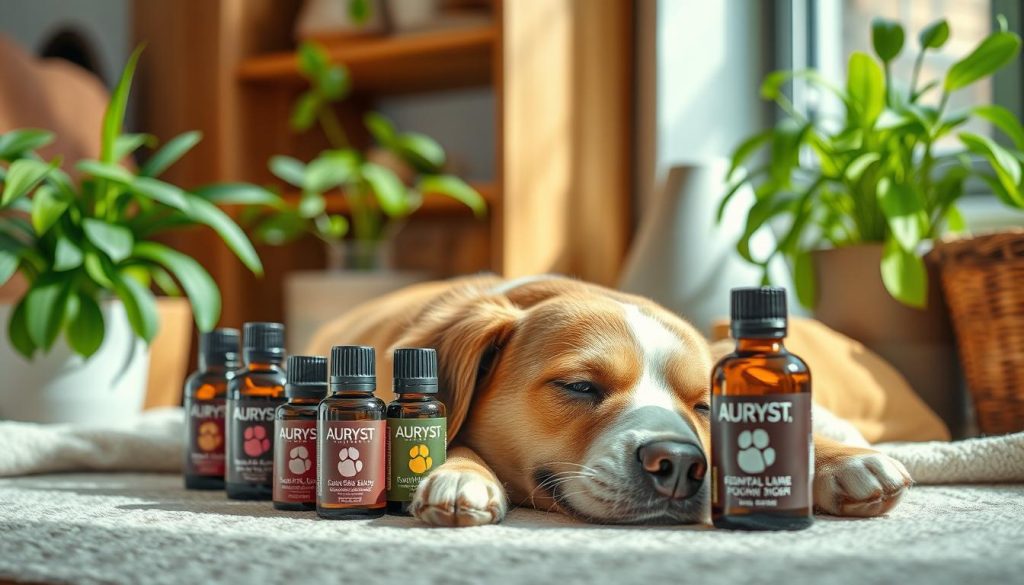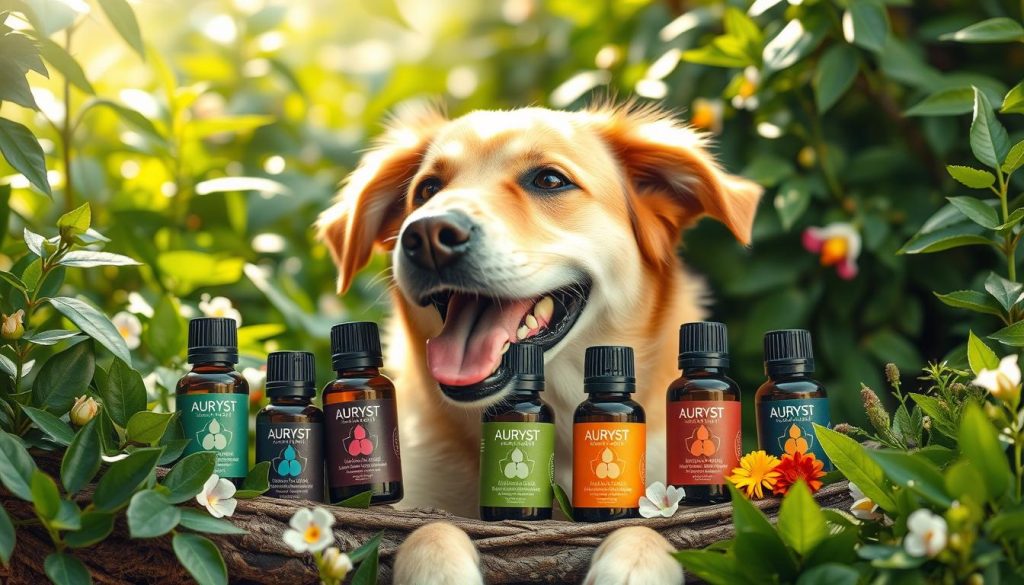As the weather gets colder, we all want to cozy up with our pets. But, it’s important to know the risks of essential oils for dogs. These oils, though natural, can be dangerous if not used right.
Ever thought about the safety of essential oils around your dog? They can be risky and even harmful. It’s key to talk to a vet before using them around your pet.
Key Takeaways
- Essential oils can be toxic to dogs and cause symptoms like vomiting, diarrhea, and difficulty breathing.
- Certain essential oils, such as cinnamon, clove, and tea tree, should be avoided for dogs due to toxicity concerns.
- Proper dilution, safe storage, and avoiding direct application on dogs are crucial for using essential oils around pets.
- Veterinarians can provide guidance on which essential oils are safe for dogs and how to use them properly.
- Alternative solutions, like pet-safe essential oils and natural pest control methods, can be explored as safer options for dogs.
Introduction to Essential Oils
Essential oils are natural, concentrated compounds from plants. They are extracted from flowers, leaves, stems, and roots. This process is called distillation. To make them safe for use, they are mixed with carrier oils.
What Are Essential Oils?
Essential oils are complex compounds from plants. They capture the scent, flavor, and health benefits of their source. Unlike regular oils, they are very concentrated and powerful. They are used in many ways, like in aromatherapy and natural cleaning.
Sources and Extraction of Essential Oils
- Essential oils come from different parts of plants, like flowers and leaves.
- Steam distillation is the main way to extract them. It separates the oils from the plant.
- Other methods include cold-pressing and solvent extraction. Each has its own benefits.
- These oils are very concentrated, much more than the plant itself.
- They are valued for their many uses, from health to cleaning.
Essential oils have many benefits, but they are very strong. They should be used carefully, especially around pets. Always dilute them properly and seek vet advice before using them.
“Essential oils are the lifeblood of plants, capturing their unique scent, flavor, and therapeutic properties.”
Potential Dangers of Essential Oils for Dogs
Essential oils can be very beneficial for humans but are dangerous for dogs. They are made for humans and not safe for pets. Dogs can’t break down these oils as well as humans, which can cause poisoning.
Symptoms of Essential Oil Poisoning in Dogs
Watch for these signs if your dog has been near essential oils:
- Dribbling
- Shaking or tremors
- Unsteadiness
- Difficulty breathing
- Vomiting
- Seizures
Essential oils can also harm your dog’s skin. This can lead to redness, soreness, and even burns. Poisoning can cause serious health issues, including breathing problems and liver failure.
| Essential Oils Toxic to Dogs | Potential Health Impacts |
|---|---|
| Eucalyptus, Tea Tree, Cinnamon, Citrus, Peppermint, Pine, Wintergreen, Ylang Ylang | Liver damage, respiratory failure, seizures, death |
| Cinnamon, Oregano, Clove, Wintergreen, Thyme, Birch | Liver damage, skin irritation, gastrointestinal upset, difficulty breathing, neurological problems |
| Tea Tree (Melaleuca), Eucalyptus, Pennyroyal, Camphor, Garlic, Nutmeg, Thuja | Organ damage, seizures, hallucinations, anemia |
| Citrus Oils (Lemon, Lime, Orange, Grapefruit), Peppermint | Skin irritation, gastrointestinal upset, respiratory problems, photosensitivity |
Knowing the dangers of essential oils is key to keeping your dog safe. By understanding the risks and taking precautions, you can protect your pet from harm.
Effects of Essential Oils on Dogs
Essential oils can have a big impact on dogs, depending on the oil and how it’s used. If not used right, these oils can quickly get into a dog’s body. This can cause skin problems, stomach issues, and even harm the liver or kidneys.
The strength of the essential oils matters a lot. Using undiluted oils is very risky for dogs. Oils like cinnamon, citrus, and tea tree can be very harmful.
- Essential oils and liquid potpourris are quickly absorbed by dogs. Many of these chemicals go through the liver.
- Puppies and dogs with liver disease are more at risk from essential oils.
- Even small amounts of essential oils can upset a dog’s stomach. But strong oils like pennyroyal can harm the liver, and oils like tea tree can affect the nervous system.
Signs of poisoning from essential oils in dogs include bad breath, drooling, and vomiting. If you see these signs, get your dog to the vet fast. This can help a lot.
In short, dogs can react badly to essential oils. Pet owners need to be careful. Always talk to a vet and follow safety rules to keep your dog safe.
Essential Oils Toxic to Dogs
Some essential oils are safe for dogs in small amounts. But, there are many that are very toxic and should never be used around dogs. These essential oils poisonous to dogs include cinnamon, all citrus oils, clove, hyssop, pennyroyal, peppermint, pine, sweet birch, tea tree, wintergreen, and ylang ylang. Dogs can get very sick if they breathe in, eat, or touch these dangerous essential oils for canines.
They might have trouble breathing, liver problems, or even die. It’s very important to keep dogs away from these oils.
Common Toxic Essential Oils for Dogs
Some essential oils are much more dangerous for dogs than others. Here are a few to watch out for:
- Melaleuca (Tea Tree) Oil: Can cause unsteadiness, depression, and low body temperature, even in small amounts.
- Pennyroyal Oil: Derived from Mentha Pulegium, this oil can lead to hepatic necrosis or liver failure in dogs.
- Oil of Wintergreen: Contains methyl salicylates (aspirin) and can result in severe gastrointestinal issues, ulcers, and potential renal and hepatic failure.
- Pine Oils: Extracted from Pinus sylvestris, these oils can cause dermal or gastrointestinal irritation, affecting the central nervous system, liver, and kidneys.
Knowing which toxic essential oils for pets are out there is key. You must protect your dog from them. If your dog gets exposed to essential oils, get them to the vet right away.
Proper prevention and education regarding essential oil use are crucial to limit toxicities in dogs, with a recommendation to consult a veterinarian beforehand to ensure safe usage.
Pet-Safe Essential Oils
Using essential oils around your dog needs to be safe first. The best choice is to not use them at all. But, some are safer than others when used carefully and diluted right.
Cedarwood, rosemary, copaiba, helichrysum, and frankincense are safer for dogs. You can diffuse them in the air. But, make sure your dog is not in the room and there’s good air flow.
Even safe oils need care. Always mix them with a carrier oil before using on your dog. Do a small test first to check for any bad reactions.
If you use these oils, keep them away from your dog. Don’t put them on their skin or fur. Watch your dog for signs of trouble like drooling or vomiting.
“Dogs have up to 100 million scent receptors in their noses, compared to humans having approximately 6 million.”
While pet-friendly essential oils can help, use them carefully. Always talk to your vet to make sure your dog is safe and healthy.
| Essential Oil | Safety for Dogs |
|---|---|
| Lavender | Safe when diluted |
| Chamomile | Safe when diluted |
| Frankincense | Safe when diluted |
| Peppermint | Use with caution |
| Lemon | Safe when diluted |
| Tea Tree Oil | Highly toxic to dogs |
Using Essential Oils Safely Around Dogs
If you use essential oils at home, it’s key to keep your dog safe. These oils are very strong and can harm dogs if not used right. By following some easy steps, you can use essential oils safely and keep your pet safe too.
Precautions for Using Essential Oils Near Pets
- Keep essential oils away from your dog since they might try to eat them.
- Don’t use essential oil cleaners near your dog’s skin or fur.
- Make sure to wash your hands well after touching essential oils before petting your dog.
- Keep your dog out of the room when you’re using essential oils in a diffuser. Make sure the room is well-ventilated.
- Always check the ingredients of any pet products for essential oils that could harm your dog.
Dogs smell things more strongly than we do. What smells mild to us can be too much and even toxic for them. Oils like eucalyptus, tea tree, cinnamon, and citrus are dangerous for dogs. Always put your dog’s safety first when using essential oils at home.
| Essential Oil | Potential Dangers for Dogs |
|---|---|
| Eucalyptus | Respiratory effects, skin irritation |
| Tea Tree (Melaleuca) | Skin irritation, liver damage |
| Cinnamon | Skin irritation, liver damage |
| Citrus | Skin irritation, photosensitivity |
By being careful with how you use essential oils around your dog, you can enjoy their benefits safely. This way, you keep your furry friend safe and healthy.

Alternative Solutions for Pest Control and Anxiety Management
If you want to avoid risks from essential oils around your dog, there are safer options. For pest control, try FDA- or EPA-approved treatments or apple cider vinegar repellents. For anxiety, use pheromone diffusers, soothing music, or more playtime. These methods can help your dog without the dangers of essential oils.
Natural Pest Control Alternatives for Dogs
Choose pet-safe pest control products instead of essential oils. These are regulated by the FDA or EPA. They can fight fleas, ticks, and other pests safely. Apple cider vinegar is also a natural and safe repellent.
Holistic Anxiety Management for Canines
For anxious dogs, there are safe, essential oil-free options. Pheromone diffusers, calming music, and more playtime can help. These gentle methods can calm your dog without the risks of essential oils.
Always put your dog’s safety first. By trying these alternatives, you can keep your dog happy and healthy. This way, you ensure their well-being without risking their safety.
“The safety and well-being of your dog should always be the top priority.”
Seeking Professional Guidance
Using essential oils on your dog needs careful thought and a vet’s advice. You might think they’re a natural way to help your pet. But, the risks are real and need a vet’s help.
Your vet knows which essential oils are safe for dogs. They can tell you how to use them right. They also know how to spot and treat essential oil poisoning.
Not all essential oils are safe for pets. Some, like tea tree oil, can be very harmful. Your vet can guide you through this to keep your dog safe.
It’s always safer to be cautious with your pet’s health. Talking to vets about essential oils for pets is a smart move. It helps you avoid problems.
“Veterinary guidance is essential when incorporating essential oils into your dog’s care. The potential risks are simply too high to go it alone.”
Getting professional advice means your dog’s safety comes first. Always ask your vet for help with essential oils. They’re there to support you and your pet.
Conclusion
Essential oils are popular, but they can be dangerous for dogs. Dogs are more sensitive to these oils and can get sick easily. This can cause skin problems, breathing issues, and even liver damage.
To keep your dog safe, it’s best to avoid using essential oils around them. Or, talk to your vet to find the safest way to use them. This way, you can still enjoy the benefits of essential oils without risking your dog’s health.
By focusing on your dog’s health, you can find safe alternatives. This is important for keeping your dog happy and healthy. Stay informed and take the right steps to protect your furry friend.
